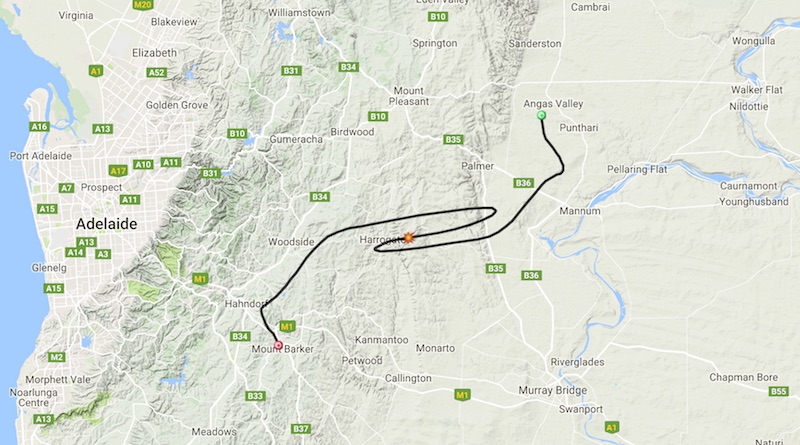Weather conditions are now looking somewhat better for a launch on Monday the 2nd of January. Liftoff is planned for 10.00am ACDT.
Ground wind conditions at Mt Barker should be light, and the current prediction (with some tweaking of launch parameters), has us landing somewhere north-east of Palmer:
Launch Details
The team will be launching from the Mt Barker High School oval. Our NOTAM’d launch time is 10AM ACDT, so we will be on-site from about 8:30-9AM. It is expected that balloon filling will take a bit longer this time, as we really need to get the balloon fill spot-on to achieve the desired flight path. Given this is an AREG test launch, visitors from the Amateur Radio community are welcome!
Payloads
There will be 5 payload boxes on this flight! (The most in a while)
- RTTY Telemetry (434.650 MHz 8N1 ASCII 100baud) – The usual RTTY payload as has flown in the past.
- Flight Control payload (TDMA) – we use this for telecommand to terminate the flight at the right altitude
- Secondary Test Flight Control Payload (TDMA) – In-air test of new TDMA software updates.
- Wenet Imagery Payload – 441.200 MHz 115Kbit/s Wideband FSK
- GoPro HD Hero 3 Video Payload – 25fps 1080p video – to be collected after landing
As usual, you’ll be able to select the flight from a drop-down list in dl-fldigi to decode the RTTY.
Tracking will be available via habhub.org 
Wenet SSDV imagery will be available via ssdv.habhub.org/VK5QI
Wenet Payload
For those club members involved in the Wenet payload data collection. you *should* be able to decode it using the software stack from last flight, however some Raspberry Pi firmware updates have slightly adjusted what ‘115200 baud’ actually means (115387 -> 115177 baud). Receivers running the old software are going to see a fairly large symbol rate error, and may experience a performance hit because of that. While the old software should work, the best preparation would be to upgrade your software.
As an upgrade, this flight will be sending ‘Full HD’ 1080p images, which should make nice desktop backgrounds! Note that this flight will be sending maybe 2x the number of images as the previous flight, due to some threading improvements made to the software.
As always, the Wenet ground-station software is available on Github at: https://github.com/projecthorus/wenet with an install guide for Ubuntu Linux here. A RTLSDR and a 70cm preamplifier are required for reception.
Launch Site Map
For those who want to see the balloon filled and lift off, here is the venue:
[wpgmza id=”10″]

